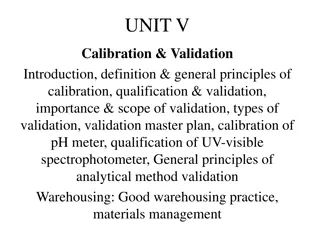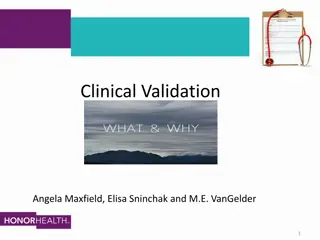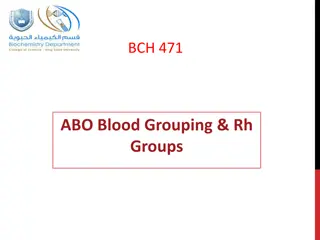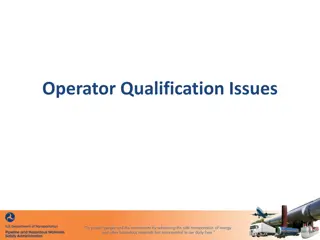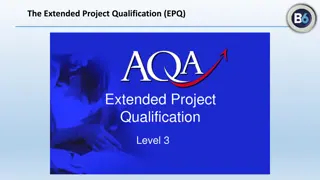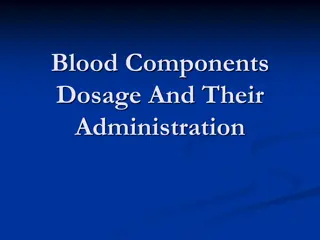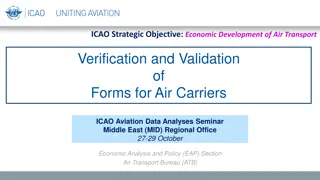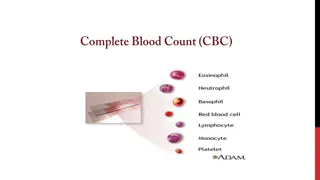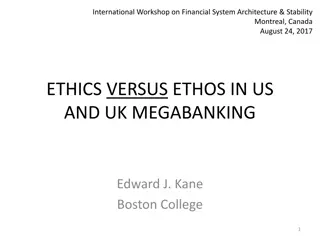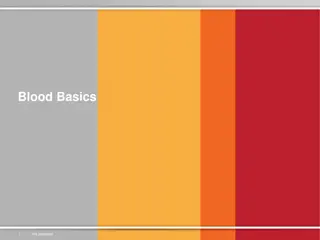Blood Bank Validation, Verification, and Qualification Plans by Theresa Dunning
An in-depth look at validation, verification, and qualification plans in the Blood Bank field by Theresa Dunning, covering definitions, standards, and agencies involved, with a focus on ensuring equipment meets intended use specifications and requirements set by regulatory bodies like AABB, CAP, FDA, and CMS (CLIA).
Download Presentation

Please find below an Image/Link to download the presentation.
The content on the website is provided AS IS for your information and personal use only. It may not be sold, licensed, or shared on other websites without obtaining consent from the author.If you encounter any issues during the download, it is possible that the publisher has removed the file from their server.
You are allowed to download the files provided on this website for personal or commercial use, subject to the condition that they are used lawfully. All files are the property of their respective owners.
The content on the website is provided AS IS for your information and personal use only. It may not be sold, licensed, or shared on other websites without obtaining consent from the author.
E N D
Presentation Transcript
Validation, Verification and Qualification plans for all things in the Blood Bank THERESA DUNNING, MT(ASCP)SBB, MSQA, CMQ/OE(ASQ) CBBS QSE, REGIONAL SEMINAR
Disclosures No conflicts of interest.
Learning Objectives Describe the difference between a validation, verification and qualification plan. List one process or equipment example to illustrate what would need a validation, verification or qualification test plan. List 1 2 references or resources that can assist with developing an appropriate test plan.
AABB Definitions Validation versus Verification Validation: Establishing recorded evidence that provides a high degree of assurance that a specific process will consistently produce an outcome meeting its predetermined specifications and quality attributes. (IQ, OQ and PQ) Verification: Confirmation by examination and provision of objective evidence that specified requirements have been met. (IQ and OQ)
Agencies Requiring Validation/Verification AABB CAP FDA CMS(CLIA) Guidance / Reference Documents FDA Guidance CLSI Clinical Laboratory Standards Institute
AABB Standards 3. Equipment 3.2 Qualification of Equipment All equipment shall be qualified for its intended use. Equipment repairs and upgrades shall be evaluated and equipment re-qualified, as appropriate, based on the facility s policies and manufacturer recommendations. 3.2.1 Installation Qualification Equipment shall be installed per manufacturer s specifications.
AABB Standards 3.2.2 Operational Qualification The functionality of each piece of equipment and each component of a computer system shall be verified before actual use, and shall meet the manufacturer s operational specifications.* *FDA Guidance for Industry: Blood Establishment Computer System Validation in the User s Facility (April 2013) 3.2.3 Performance Qualification The BB/TS shall demonstrate that equipment performs as expected for its intended use. Performance specifications established by the manufacturer shall be met.
AABB Standards 3.9 Information Systems The BB/TS shall have processes to support the implementation and modification of software, hardware, and databases relating to the requirements of these BB/TS Standards .These processes shall include: 1) Risk analysis, training, validation, implementation, and evaluation of post-implementation performance.
CAP Standards COM.30550 Instrument/Equipment Performance Verification The performance of all instruments and equipment is verified prior to initial use, after major maintenance or service, and after relocation to ensure that they run according to expectations. Instrument/equipment performance verification includes processes to verify that the instruments and equipment perform according to expectations for the intended use and within defined tolerance limits.
CAP Standards TRM.22000 LIS Transfusion Validation The laboratory information systems are validated for blood banking/transfusion medicine activities. NOTE: The LIS must be validated at initial installation, and when a change is made to the system.
FDA Regulation cGMP regulations: 21CFR parts 210 and 211 In summary, these regulations require that manufacturing processes be designed and controlled to assure that in-process materials and the finished product meet predetermined quality requirements and do so consistently and reliably. 211.100(a) states there shall be written procedures for production and process control designed to assure that the drug products have the identity, strength, quality, and purity they purport or are represented to possess...
FDA Guidance Process Validation: General Principles and Practices (January 2011) Blood Establishment Computer System Validation in the User s Facility (April 2013) - (BECS) Risk Assessment
CMS Clinical Laboratory Improvement Amendments (CLIA) Verification of Performance Specifications Brochure #2 Accuracy Precision Reportable Range Reference Intervals Apples to Patient Test Performance
CLSI Clinical Laboratory Standards Institute CLSI ILA33-A:2009 Validation of Automated Systems for Immunohematological Testing Before Implementation, 1st Edition CLSI EP18-A2:2009 Risk Management Techniques to Identify and Control Laboratory Error Sources, 2nd Edition Laboratory Best Practice guidelines
Validation, Verification, Requalify New Equipment /Software IQ OQ PQ FDA Risk Assessment BECS CLIA Test Specifications Requalify after moving, repair, post implementation monitoring Validation Verification Ortho Vision Analyzer X X X X X X Blood Irradiator X X X X X BB Plasma Thawer X X X X Blood Storage Cooler X X X X BB Refrigerator X X X Electronic XM X Digitrax Label printer X X X X BB Cell Washer X X X
Validation, Verification, Requalify New Equipment /Software IQ OQ PQ FDA Risk Assessment BECS CLIA Test Specifications Requalify after moving, repair, post implementation monitoring Validation Verification Blood Warmers X X X Bellmont Rapid Infuser Haemonetics 5+ X X X X X X X Pneumatic tube transport system X X X X
Required Documentation for Validation Written Plan People, roles and responsibilities Biomedical, Field Service Engineer, CLS, Project Managers, Project Sponsors IT support staff, BECS interface Software change control Laboratory Medical Director as a final approver Equipment documentation from the vendor Operating instructions, environmental requirements, performance specifications Equipment / Analyzer customer configuration Risk assessment Sequence of testing IQ, OQ, PQ
Required Documentation contd Written Procedures for assessing and/or testing each element (IQ, OQ, PQ) Includes vendor performance specifications and customer quality attributes Training for those individuals that will conduct the test cases Data collection evaluation and final summary with approvals Problem resolution process defined Post approval Operational SOPs developed based on final analysis Lessons learned Staff Training and Competency Implementation of the new equipment / analyzer Monitoring for any potential unforeseen issues
Ortho Vision Validation Plan
Scope Roles & Responsibilities
IQ based on manufacturer s specifications
Acceptance Criteria
Validation Summary
Laboratory Pneumatic Tube for Specimens and Blood Product transport Uses formal validation plan with IQ, OQ and PQ IQ assessment of the pneumatic tube installation specifications, mapped routes OQ assessment of the basic functions, programming, longest route, routes exposed to exterior temperatures PQ Use paired patient test samples 1st ) sent to the lab 2nd) sent though the tube PQ Blood product visual assessment before and after tube transport, pRBCs evaluated for increased hemolysis (pre and post transport plasma hemoglobin measured)
Blood Bank Equipment IQ & OQ
Qualification / Requalification Examples: Small table top equipment such serofuge for manual tube testing: Verification Upon initial installation & calibrate manual test tube method performance Measure rpm/timer at 6 month intervals Daily QC Requalify: If moving from one bench top to another perform basic maintenance, daily QC
Requalify - Blood Transport Coolers Initially new coolers are validated Use expired blood products and pack in various configuration Measure time and temperature, using a NIST thermometer Define policy on remote blood storage use based on data Yearly Requalify each cooler based on: Visual integrity of the contain, lid closure







